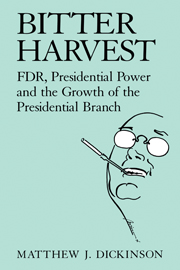Book contents
- Frontmatter
- Contents
- Preface and acknowledgments
- Introduction: The fruits of his labor? FDR and the growth of the presidential branch
- Part I Concepts and controversies
- Part II From cabinet to presidential government, 1933–9
- Part III Testing Roosevelt's staff system: The war years, 1939–45
- Part IV Lessons and considerations
- References
- Indexes
Preface and acknowledgments
Published online by Cambridge University Press: 21 January 2010
- Frontmatter
- Contents
- Preface and acknowledgments
- Introduction: The fruits of his labor? FDR and the growth of the presidential branch
- Part I Concepts and controversies
- Part II From cabinet to presidential government, 1933–9
- Part III Testing Roosevelt's staff system: The war years, 1939–45
- Part IV Lessons and considerations
- References
- Indexes
Summary
It was as Richard Neustadt's graduate student, and later as his teaching assistant, that I first began to think about the presidential “branch,” the White House-centered advisory system that is an increasingly influential actor in presidential politics. Neustadt, of course, as a former Bureau of the Budget official, a White House aide to Harry Truman, and informal adviser to almost every one of Truman's presidential successors, knows perhaps as much as anyone about this topic. But Presidential Power, his seminal book on the American presidency, touches only tangentially on presidential advising, and then only to warn presidents not to expect aides to provide the support and advice presidents need, when they need it.
The rapid growth of the presidential branch since Presidential Power was first written, however, and its evident role in a series of disastrous presidential decisions – escalating the American presence in Vietnam, the Watergate cover-up, and the Iran-contra affair are perhaps the most prominent – convinced me that the subject deserved more study. What explains the rate and locus of presidential branch growth? How to understand its internal configuration, including levels of hierarchy and role specialization? Most important, what overall impact does it have on a president's effective influence on governmental outcomes?
Previous scholarship evinces no consensus on these questions. In part, this reflects the diversity of research methods that have been utilized.
- Type
- Chapter
- Information
- Bitter HarvestFDR, Presidential Power and the Growth of the Presidential Branch, pp. vii - xPublisher: Cambridge University PressPrint publication year: 1996



